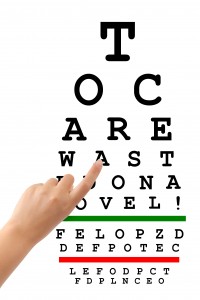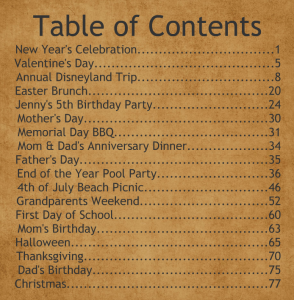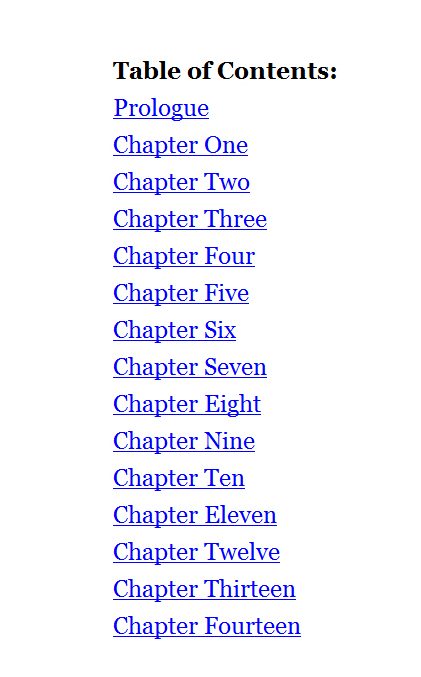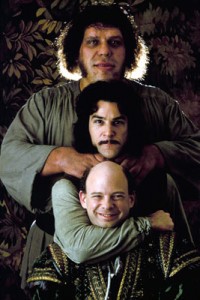 I actually started a blog on this subject yesterday, was pulled away, and never got back to finishing it. Then this morning I had an email/ticket from Amazon in my inbox because a reader complained that my FICTION book does not have a Table of Contents (referred to more lovingly in the writing community as the TOC). When did this completely useless and logic-bending trend of putting a TOC in an eNovel begin (and when exactly did Amazon begin employing mind-readers)?
I actually started a blog on this subject yesterday, was pulled away, and never got back to finishing it. Then this morning I had an email/ticket from Amazon in my inbox because a reader complained that my FICTION book does not have a Table of Contents (referred to more lovingly in the writing community as the TOC). When did this completely useless and logic-bending trend of putting a TOC in an eNovel begin (and when exactly did Amazon begin employing mind-readers)?
Before going any further, let’s be one hundred percent clear: I’m talking about a TOC for NOVELS. And most fiction, for that matter. I can imagine, I suppose, maybe, an Historical Fiction book or some other strange hybrid of novel that might benefit from a TOC. A collection of poems? Absolutely. A gathering of distinct and independent short stories? Of course. But for 99.999% of the Fiction genres and books out there? Please. Pretty soon they’ll be demanding them for the stand-alone short story, so you can go to any break in the text and back to the beginning again!
When I first read Smashwords founder Mark Coker’s outstanding (and free) eBook on eFormatting your writing (Smashwords Style Guide: How to Format Your Ebook), I was first introduced to the concept of a fiction book having a Table of Contents. Smashwords will not even distribute your eBook to other outlets without one. So at the time, because I was using Smashwords and I wanted my eBook in online stores like Barnes & Noble, I went through the grueling, laborious task of creating a TOC for my books. (I exaggerate; it IS a bit time consuming and can give you fits with formatting at times, and it makes your eNovel look like cheap, hyperlink crap, but it’s doable.) I even created the recommended link for each chapter heading which makes it look like a cliché, hideous blue hyperlink rather than a nicely-formatted chapter heading.
CHAPTER ONE
versus
The whole process and, worse, finished product, made me realize how utterly (and maddeningly USELESS) a TOC is for a novel. To punctuate my point, this is what my first TOC for Black Beast looked like (Hint: it looks exactly like the TOC for the other books with which I took the time to create one):
Pretty helpful, isn’t it? Wow, I wonder what Chapter Nine is all about? Really piques the interest. And if you ever need to get back to the good old TOC, just click the morbid blue hyperlinked chapter heading and you can return and choose the next chapter from where you want to begin reading. (I know, you can change settings in your Word document to handle hyperlinks without making them look like a sixth-grader made them, but that feeds into a point we’ll get to in a minute: wasting my freaking time.)
 Now I am absolutely NOT belittling the TOC in general. Holy cannoli, for nonfiction? An absolutely necessity. Can you imagine college without a TOC for every boring textbook on Macroeconomics or Russian History or Abstract Algebra? Seriously—in nonfiction books, the TOC makes perfect sense. But in a novel, I cannot think of one possible use for one. The TOC is supposed to exist where there is original content of some kind tied to each chapter or to certain pages in the book (see the TOC I included; this family seems to have had a really fun year, by the way).
Now I am absolutely NOT belittling the TOC in general. Holy cannoli, for nonfiction? An absolutely necessity. Can you imagine college without a TOC for every boring textbook on Macroeconomics or Russian History or Abstract Algebra? Seriously—in nonfiction books, the TOC makes perfect sense. But in a novel, I cannot think of one possible use for one. The TOC is supposed to exist where there is original content of some kind tied to each chapter or to certain pages in the book (see the TOC I included; this family seems to have had a really fun year, by the way).
eReaders have bookmarking features. Highlighting features. Note-taking abilities. Why on God’s green earth would you want to have 2-3 pages wasted in a novel with a TOC? To tell you where Chapter 23 is? What the hell do you know about Chapter 23 that I, the writer, don’t even know?
(And by the way, what was the last hardback or paperback novel you bought that had a Table of Contents?)
Yet now I have Amazon essentially strong-arming me into creating one and resubmitting my manuscript.
 I am aghast. No, “aghast” doesn’t begin to describe how I feel. I am pissed. I made my stand on my latest book. Death to the TOC in fiction books. My novel has a five-star rating. Now suddenly I am in conflict with a policy that essentially states that my newly-designed kick-ass adult road bike must have training wheels before the bike store will sell it because some weaselnut complained he couldn’t ride one without?
I am aghast. No, “aghast” doesn’t begin to describe how I feel. I am pissed. I made my stand on my latest book. Death to the TOC in fiction books. My novel has a five-star rating. Now suddenly I am in conflict with a policy that essentially states that my newly-designed kick-ass adult road bike must have training wheels before the bike store will sell it because some weaselnut complained he couldn’t ride one without?
Am I missing something? I am being completely serious. What is it that I am missing here? Am I the only author that thinks a Table of Contents for a novel is as worthless as my grandpappy would say “teats on a boar”? (And yes, I purposely cleaned that one up a skosh.)
Time is such a precious commodity. For all of us, but perhaps more so for the writer who holds down a day job, plus a writing job, and then 3-4 other full-time positions (Editor, Proofreader, Cover Designer, Marketer, Accountant, etc.). So I get a little heated when I am asked to waste mine.
To you it may sound petty, and yes, we pick our battles. But illogical time-wasting really crawls up my craw and sticks there, you know? I probably never would have come back to this issue, but the Almighty Amazon (in addition to randomly removing reviews from my books) has now really got my craw congested (whatever the heck a “craw” is in the first place).
So until convinced otherwise, I am forming a brute squad. The TOC in a novel is my own personal Prince Humperdinck. I wish Andre the Giant were alive because I know he of all people would agree with me. Join us. We’ll be rife with torches and clubs and daggers and rope and we’ll sack every village and string up every unwarranted fiction-based TOC we find. Their time has not passed—there never should have been a time for them to begin with.
~~~~~~~~~~~~~~~~~~~~~~~~~~~~~~~~~~
The blank page is dead…long live the blank page.
~~~~~~~~~~~~~~~~~~~~~~~~~~~~~~~~~~
Eye Chart Image credit: violin / 123RF Stock Photo (Letters changed by author)
Screaming Man Image credit: dundanim / 123RF Stock Photo





You have to have a TOC for fiction? Da fuq? Here’s an idea: If they really won’t allow you to put your novel up with a TOC, why not make them links to your blog & other fun sites?
There was something else I wanted to mention (or maybe ask), but I don’t remember what it was…
That’s actually an excellent idea! I’m not sure they would actually pull it off the site for that–they definitely don’t stop from posting it (my book’s been up there for months). And Smashwords will let you upload it to them, but they won’t distribute to the other outlets (which is half the point of using Smashwords in the first place). Pretty stupid if you ask me (not that anyone did). 😉
The sad thing is, all the big publishers are doing it, too, with their big authors / big books. I can’t believe someone with half a brain didn’t stand up and say “whoa, whoa, this is FICTION people, we don’t need to clutter up the pages with Chapter One, Chapter Two, etc. links. For super long novels it can end up being 15 pages of TOC on your Kindle screen.
I’ll add this to the file of things that are forehead slappingly frustrating.
Really…you’re really gonna shit can somebody for NOT having a TOC…in a work of fiction…in an eBook.
J.H.C.
Entertaining as always Sir.
J.H.C. I like that. May have to steal that one from your D.F.A. 😀
I know, it’s freaking ludicrous. And that someone would complain…just boggles the mind.
The sad thing is, the big publishers are complying and putting a TOC in their fiction books. Chapter 1, Chapter 2, Chapter 3…next thing we’ll need “Walk” signs all along the sidewalks and “Swim” signs at all the pools and “Drink” signs at every seat in a pub. Guide me. Direct me. Tell me what I’m supposed to be doing…
Hi Rob, Alana, also from Australia here. I’ve been wondering about their use too. I have tried rationalising it with it being a method of refinding your place in an eBook when you lose it — and I do lose it, when I’m trying to skip back to find something and can’t remember a keyword to make a search — or at least getting back close to where you were reading. But, like location numbers, that presupposes you took any notice of the number or chapter you were in in the first place. Can’t beat a hard copy for that. But the rationalisation doesn’t work. No, I can’t see the point of TOCs in novels either.
You know it’s funny, I thought the same thing—what if they forgot their place (which is kind of hard to do, at least on a Kindle, because it always opens where you left it—but like you said, if you skip back and don’t bookmark (which I do, too) but then I just flip ahead to the last thing I read, having not remembered the chapter number anyway. Plus, there will always be the one-off reason, I suppose, but over all (like to the tune of 99%+), yep, ridiculous.
To me the worst thing is it doesn’t seem anyone (major publishers included) are questioning it. It’s like we’ve all become a bunch of zombies and do whatever the booksellers say. I’m going to wait it out and see what they say or do…remember me when I’m gone! 😉
I had this conversation with a non-writer friend of mine. He loves when eBooks have a TOC. I didn’t get it at first either, but I’ll see if I can summarize his thoughts and then add my own:
He reads on just about every device he owns. He has a Kindle, but also has the Kindle app on his phone and computers. He reads a lot and loves the flexibiltity of always having the current book at his fingertips. But if something isn’t working with their sync, or if you’re reading something you didn’t purchase directly from Amazon, you need to search for where you left off last time. If you know what chapter you were on (I can’t speak for everyone, but I’m a read-by-the-chapters type of guy, so I usually know what chapter I’m on) then you can jump to the TOC and quickly get to your chapter. My friend says the TOC is a must for him.
I recently had this experience when I was reading Game of Thrones. I found that the nature of that book, with all the names and maps and whatnot, didn’t work well for me solely on an eReader, so I bought a used hardcopy too. I sometimes didn’t have that book with me (like at work) but had some free time to read. The TOC was a godsend for getting me back to the proper spot. I’m now a big fan of the TOC in eBooks.
Thanks for the comment, JJ. Like everyone, I’ve gotten lost, too (after perhaps going back and rereading something or whatever) but I’m always more cognizant of how far into the book I am/was (e.g. 40%) and I remember the last scene a lot more vividly than an unnamed chapter (Chapter 34—if my life depended on it, I’d probably never be able to tell you the exact number of the chapter I’m in). As with real books, I bookmark. Done. One click. I fail to understand why going to the TOC, clicking on the chapter (for those with numbers brains that remember exactly which chapter they were in), then surfing said chapter to find your place, is preferable to using a bookmark. I’m just a practical guy who likes to pay respects to the engineers who worked hard to give me an easy way of finding my place on any device by using the feature.
Honestly, I have changed my opinion on the TOC for a novel a bit. At least now I see where for some people it can be an advantage. I’ve seen some points of view that enlightened me to uses I hadn’t thought of myself (which is why I love blogs, civil discourse, etc.). That being said, I would love to see a survey question; just a simple one:
Do you think a TOC for a novel with only chapter numbers is useful?
O Yes
O No
I’m not going to guess at the percentages—it might be surprising. And I’m always willing to change my stance if the empirical evidence is there. I received a link from another writer/editor to Amazon’s explanation of “why”. Like me with these comments, she said she saw some of the points (something about tick marks with Apple) but to me still didn’t seem swayed. I haven’t read it yet, but I plan to. I was thinking of doing a follow-up blog with “the rest of the story”. Thanks for weighing in. 🙂
I forgot to mention the tick marks. I see them on my Kindle too. As one of those (OCD?) people who always reads by chapter, it’s really handy to have a visual approximation of how long the next chapter will be. I prefer not to flip ahead pages because that can mess up the sync on other devices. But a quick glance at the bottom of the screen tells me if I’m in for 10 minutes or a half hour. Nice to know when I need to do something but have a small amount of time to kill.
I find myself saying this on many author blogs (I’ve said it here before too, so I apologize for repeating myself): Happy customers are returning customers. Don’t forget that your readers are your customers. If a TOC is important enough to them that Amazon contacted you about it, then it’s important enough for you to include in your eBooks.
Another salient point, JJ. You know I actually played around with putting the TOC in the book and as long as the Chapter headings are set as Heading 1 in Word, inserting a linked TOC takes about three seconds. And as I mentioned in the blog, you can set it so that your links are not BLUE and underlined (but they still show up underlined in the final Kindle conversion. Oh well, I’m sliding off the fence on this one.
Not once in my life have I ever bought a book because I was enamored and enthralled with a novel’s Table of Contents. I’ve always believed that were a waste of paper. Now, on eBooks, they’re a waste of space.
Couldn’t agree more. I hope one day we get to sit down face to face and chew the rag, Caleb. I have a feeling it would be a rewarding experience. 🙂
Maybe I’m a Luddite. I finally got a Kindle and love reading books on it. I have lost my place at times and I guess I’m not good at working my way around the device. Those novels that had a TOC helped me a lot even if it is just a list of chapters. I could click on a chapter and find out if I read it. Made it much easier to find my lost place. Maybe it won’t be necessary once I get better at Kindle, but for now I found it helpful. That being said, I wouldn’t write that as a complaint for a book. One complaint I do have is a book I read that had references. I would click on the reference to read where the author got his information and then there was no way to click back to the text. Made it frustrating.
I don’t think you’re a Luddite. There are a lot of folks out there, I think, who are not of the new “electronically-gifted” generation. I get that a TOC can come in handy for some people. The irony to me is that even though I am a technical guy, every new device is just as strange and seemingly complicated at first and I am lost for a while, too, poking around, etc. But it’s not difficult to use the bookmark feature. And every time you open a book it should be on the last page it was on when you exited. I say (not to you personally, just to the world at large) “figure out the device rather than make every author in the world spend hours formatting and linking chapter headings for every book so you don’t have to use the bookmark feature built into your reader”. I don’t know, maybe that just makes me an anti-Luddite. I hope not. I swear, I love everyone. 🙂
Seriously, thanks for voicing the other side of the TOC story, Heather. And for reading. TGIF!
Wow. It didn’t occur to me that it was “required”. I figure it should be up to you. It’s your book.
Perhaps because I use Scrivener, it simplifies putting in a TOC with titles rather than just numbers. I actually had fun with it in my latest crime novel because, except for the last two chapters, all the chapter titles are movie titles (my protagonist is a hit man obsessed with movies.) For instance, when the hit man goes to group therapy at the VA, the chapter title is “Fight Club”. I used the chapter titles as a nod to some noir movies, too, so I looked at it as an opportunity to add value, at least to cinemaphiles. Generally, though? TOCs are not that helpful and, like I said, should be up to your choice.
Well first I love the way you did your chapters. Very cool, very sleek. My last one I have a verse from a song before each chapter title page…now those, I think, deserve linking to (which I might just try to do). Clearly if there is something distinct about the chapters, a TOC is very useful. I must admit, I have softened my POV to the point of not forming a brute squad (and just as well, because without Andre the Giant what kind of brute squad would it have been?)…apparently a TOC will put tic marks on the % line of a Kindle representing each chapter, so if it’s late and you just finish a chapter you can see how long the next one is and if you want to start it or not. Of course I usually just flip the pages forward for a while, as I used to with a regular book, and decide based on that.
But you nailed it; TOC should be the author’s choice, just as should naming the chapters or not, or putting a squiggle between sections or whatever. I can’t believe some schlub has so little time on his (or her) hands as to take the time to formally complain to Amazon about the lack of one. J.H.C. (as I learned from my friend Dean in Australia).
Thanks for the comment, Chazz.
Where it helps in e-book novels is simply to help the reader find his/her place more easily if it gets lost, which does happen annoyingly. The one thing about e-readers is that navigation isn’t always easy. Now you go have a nice Sunday and stop scowling.:)
Hi, Christina. Tell Bert to check his email. And Twitter.
Will do. I got your e-mail and stare at it longingly to answer, but truly we’re going 20/7 right now with day job. Haven’t forgotten you! Will get back.
C
Yes, it’s one of those little things in life, I suppose. I’ve been summarily (and lovingly) beaten into submission). 🙂
Interesting discussion.
I think the ToC is like a menu in a your favorite pizza place. You go in there knowing what you want, or at least you can invent a pizza combination once you’re in line staring up at the big silver pans on the wall and trying to convince yourself that you DON’T need the XL. (“I can take pizza to work on Monday! Yes! F*ck sandwiches!)
In other words, the menu (or the ToC) is there for a reference if needed (“They have paninis? Cool!”). If it’s not needed, don’t worry about it.
As for whether a novel needs a ToC? No. It’s a work of art; it only “needs” what appeals to its author (and, yes, your readers are your audience, but write for yourself first). Take the Fantasy genre, for example. ToC’s are common because they provide cool chapter names such as “Over the Hill and Home Again”. They’re a convention of the genre.
For example, the Harry Potter books all have great descriptive chapter titles which give you a hint of what’s about to happen in the chapter. It’s a teaser, like eating saltine crackers at the pizza place while you’re waiting the 20 minutes for your pizza to come out (assuming you didn’t destroy the salad bar and have Ranch dressing on your chin and in your lap).
Lest you think the tales of young Master Potter and company are crap, I can also cite books penned by one Mr. Isaac Asimov which also have fun titles listed in their ToC. Anyone who says Asimov’s books are “crap” is either stupid, ignorant, jealous, or some combination thereof.
But, your poll refers to ToC’s that just say Ch1, Ch2, Ch3, etc. I have them in my books. Why? I don’t know. . . because somewhere along the line when I was figuring out the self publishing machine, I read that it could be done and probably ought to be done. So I did it. It was easy. Case closed.
Now, I can cite a book which doesn’t have a ToC: AFRAID by Jack Kilborn aka J.A. Konrath. Now, to be accurate, AFRAID does have a ToC, but it has the following items:
About Afraid
Dedication
Epigraph
Start Reading. . . AFRAID
About J.A. Konrath
Ebooks by J.A. Konrath
Preview: TRAPPED
Copyright
That is how the ToC appears. No numbers. No Chapter __. It’s more of a hyperlinked sales pitch than a ToC.
Also of note within AFRAID is that there ARE no chapters. The book is one lonnnnng chapter. Scenes are separated by little white rectangular icons with what appears to be a blood spatter inside. This is simultaneously annoying and totally genius. It keeps you reading because there is no logical place to stop. When I read it, I read until 3:00 a.m. most nights because I was into it and the e-pages were turning and there was no stopping point denoted by a chapter break. Something to think about. Especially given Konrath’s numbers.
So, to quote Inigo Montoya, “Allow me to explain. No, there is too much. Allow me to sum up.”: If it’s Amazon’s policy for their .mobi files to have a ToC, and readers such as your complainer want one, then I guess you gotta put one in. If you don’t like it, do what Konrath did; do it your way. Play with it. Come up with something fun. Fun for you, fun for your readers.
Sorry I’ve gone one a bit. I caught some of Steve King’s diarrhea of the word processor.
“You seem like a decent fellow. I hate to kill you.”
“YOU seem like a decent fellow. I hate to die.”
I like the idea of playing around with the TOC, making it fun for the reader. Maybe my next one I will name each chapter after an item from my favorite Italian restaurant. 😉